The Industrial History of Hong Kong Group
Primary tabs
This group, formed in November 2012, is for anyone who has an interest in the Industrial History of Hong Kong. From textiles to trams, salt to shipbuilding, it’s a fascinating part of HK’s history. We cover manufacturing, transport, utilities, mining and quarrying, telecommunications and aspects of fishing and agriculture.
Our website was launched in October 2013:
http://industrialhistoryhk.org
If you feel you would like to comment on an existing article you can do so immediately. If you would like to write one of your own please go to Write For Us! where you can easily register.
Or you can contact me directly on the email address below.
I look forward to hearing from you.
Hugh Farmer indhhk[at]gmail.com


Newsletter number 8
Email Newsletter Eight, August 2013 contains articles on:-
Please click here to download a copy, or contact Hugh Farmer, indhhk@gmail.com, if you'd like to subscribe and receive future copies by email.
Industrial History website
Congratulations to Hugh on the launch of the group's website: http://industrialhistoryhk.org/
Plenty of interesting articles to enjoy.
Regards, David
The Industrial History of Hong Kong Group: Newsletter 9
Newsletter 9, November 2013, can now be seen at http://industrialhistoryhk.org/
It contains articles on:
Indhhk- appeal for personal accounts of working in HK Industry
I would be very interested to hear from anyone who has personal anecdotes or reminiscences about any aspect of Hong Kong's industrial past including those mentioned below. Whether you yourself or a family member worked in these industries, or you know of someone who left written memories or photographs, it would be great to hear about it.
We are interested in manufacturing, transport, utilities, mining and quarrying, technical education, telecommunications and aspects of fishing and agriculture.
So whether its places, people or products let us know and help to record Hong Kong's extraordinary industrial past.
Some of the articles posted in June 2014 have been:
World War Two - Kai Tak airport, BAAG maps, sketches and plans
Amoy Canning - connection to WW2 and a particular Englishman
Hong Kong & Whampoa Dock Ltd - ships built, wrecked during WW2
Kwanti Racecourse - further information and link to San Wai camp, 1930s
Tai Hing Cotton Mill 1957-2014
1939 Report on Labour and Labour Conditions in HK
1997 Construction of the HK Convention and Exhibition Centre
Please contact me if you have any comments or would like to contribute.
Hugh Farmer indhhk[at]gmail.com
Import & Export Dept 1948-50
In connection with the early development of trade & industry in Hong Kong post-War, perhaps some may find my father’s (Paul Tsui) unpublished Memoires – My Life and My Encounters (see http://www.galaxylink.com.hk/~john/paul/paul.html) interesting.
He was appointed Assistant Superintendent for Import & Export Department from 1948-50 as a Cadet Officer Class II (Junior AO). In his Chapter XVIII, he described at some length his posting to the I&E Dept upon returning from his training at Oxford & the London School of Economics.
He reported to Mr. Eric Himsworth, the Superintendent, at the 2nd floor of the Fire Brigade Building in Central, and took over from Mr. MacWhirther, who was working with another Assistant Superintendent, Mr. Wolfe Flanagan, formerly from the Chinese Maritime Customs in Shanghai. Even then, the I&E Dept was very busy with Export Licences, including the Certificates of Origin, as well as smuggling prevention services by the uniform Excise & Revenue Service. The department was rather short of human resources he said. There was another related department for Trade & Industry which eventually merged with the I&E Dept.
It was a time of renewed confidence of growth and hope, and HK was transiting from an entrepot to an industrial city. He visited most of the factories, including the small ones at Tung Tau Chuen near the Walled City, as well as the sophisticated textile factories of the Shanghainese taking refuge from the imminent Communist takeover of China. He mentioned quite a few names of factories as well as the early industrialists. He was also involved with initiating trade promotions overseas, particularly the British Industrial Fair at London. By the time, Mainland Refugees flooded into HK which fuelled subsequent industrial development, he was leaving the expanded I&E Dept for the NT Administration.